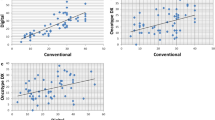Abstract
This study aimed to investigate the effect of tamoxifen on breast tumour levels of oestrogen and progesterone receptor (ER and PR) and proliferation as defined by the Ki67 antibody. A group of primary breast cancer patients was randomised to receive either tamoxifen (n = 59) or placebo (n = 44) treatment in the interval between clinic and surgery (median 21 days). Frozen sections of breast tumour biopsies obtained before and after treatment were stained immunocytochemically to obtain the percentage of nuclei containing ER and PR, and a Ki67 labelling index (LI). Tamoxifen-treated patients had a median Ki67 LI of 5.6% in the first biopsy falling to 3.0% in the second biopsy (P < 0.001 by Wilcoxon's matched pairs test), whereas placebo-treated patients had a median Ki67 LI of 5.4% in the first biopsy and 5.75% in the second (no significant difference). No significant differences were observed when the median %ER or %PR staining before and after treatment were compared. The Ki67 LI tended to increase with increasing histological grade and was greater in tumours that were ER - ve compared to those that were ER + ve (> 5% nuclei stained), median 7.8% and 4.3% respectively (P = 0.011 by Mann-Whitney U-test). However, the decline in tumour Ki67 LI following anti-oestrogen treatment failed to correlate with ER and PR status or to predict recurrence over a short follow-up period. To our knowledge, this is the first time that tamoxifen treatment has been shown to reduce the Ki67 LI in human breast tumours in vivo. These data indicate that staining with the Ki67 antibody may be useful in monitoring response to anti-oestrogen therapy.
This is a preview of subscription content, access via your institution
Access options
Subscribe to this journal
Receive 24 print issues and online access
$259.00 per year
only $10.79 per issue
Buy this article
- Purchase on Springer Link
- Instant access to full article PDF
Prices may be subject to local taxes which are calculated during checkout
Similar content being viewed by others
Author information
Authors and Affiliations
Rights and permissions
About this article
Cite this article
Clarke, R., Laidlaw, I., Jones, L. et al. Effect of tamoxifen on Ki67 labelling index in human breast tumours and its relationship to oestrogen and progesterone receptor status. Br J Cancer 67, 606–611 (1993). https://doi.org/10.1038/bjc.1993.111
Issue Date:
DOI: https://doi.org/10.1038/bjc.1993.111
This article is cited by
-
The progesterone-receptor modulator, ulipristal acetate, drastically lowers breast cell proliferation
Breast Cancer Research and Treatment (2022)
-
IPET study: an FLT-PET window study to assess the activity of the steroid sulfatase inhibitor irosustat in early breast cancer
Breast Cancer Research and Treatment (2017)
-
NEOCENT: a randomised feasibility and translational study comparing neoadjuvant endocrine therapy with chemotherapy in ER-rich postmenopausal primary breast cancer
Breast Cancer Research and Treatment (2014)
-
A randomized phase II presurgical trial of weekly low-dose tamoxifen versus raloxifene versus placebo in premenopausal women with estrogen receptor-positive breast cancer
Breast Cancer Research (2013)
-
Alteration of immunohistochemical biomarkers between pre- and post-chemotherapy: hormone receptors, HER2 and Ki-67
Breast Cancer (2011)



